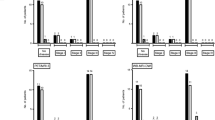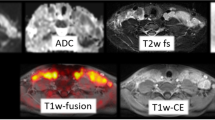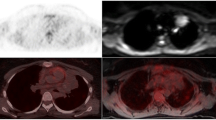Abstract
Objectives
To evaluate and compare the diagnostic potential of different reading protocols, entailing non-enhanced/contrast-enhanced and diffusion-weighted 18F-FDG PET/MR imaging for lesion detection and determination of the tumor stage in lymphoma patients.
Methods
A total of 101 18F-FDG PET/MRI datasets including a (1) transverse T2-w HASTE and 18F-FDG PET (PET/MRI1), (2) with an additional contrast enhanced VIBE (PET/MRI2), and (3) with additional diffusion-weighted imaging (PET/MRI3) were evaluated. Scans were performed for initial staging, restaging during treatment, or at the end of treatment and under surveillance with suspicion for tumor relapse. In all datasets lymphoma manifestations as well as tumor stage in analogy to the revised criteria of the Ann Arbor staging system were determined. Furthermore, potential changes in therapy compared to the reference standard were evaluated. Hitherto performed PET/CT and all available follow-up and prior examinations as well as histopathology served as reference standard.
Results
PET/MRI1 correctly identified 53/55 patients with active lymphoma and 190/205 lesions. Respective values were 55/55, 202/205 for PET/MRI2 and 55/55, 205/205 for PET/MRI3. PET/MRI1 determined correct tumor stage in 88 out of 101 examinations, and corresponding results for PET/MRI2 were 95 out of 101 and 96 out of 101 in PET/MRI3. Relating to the reference standard changes in treatment would occur in 11% based on PET/MRI1, in 6% based on PET/MRI2, and in 3% based on PET/MRI3.
Conclusions
The additional application of contrast-enhanced and diffusion-weighted imaging to 18F-FDG PET/MRI resulted in higher diagnostic competence, particularly for initial staging and correct classification of the disease extent with potential impact on patient and therapy management.




Similar content being viewed by others
References
Ryerson AB, Eheman CR, Altekruse SF, Ward JW, Jemal A, Sherman RL, et al. Annual report to the nation on the status of cancer, 1975-2012, featuring the increasing incidence of liver cancer. Cancer. 2016;122:1312–37. doi:10.1002/cncr.29936.
Lin C, Itti E, Haioun C, Petegnief Y, Luciani A, Dupuis J, et al. Early 18F-FDG PET for prediction of prognosis in patients with diffuse large B-cell lymphoma: SUV-based assessment versus visual analysis. J Nucl Med : Off Publ, Soc Nucl Med. 2007;48:1626–32. doi:10.2967/jnumed.107.042093.
El-Galaly TC, Hutchings M. Imaging of non-Hodgkin lymphomas: diagnosis and response-adapted strategies. Cancer Treat Res. 2015;165:125–46. doi:10.1007/978-3-319-13150-4_5.
Barrington SF, Mikhaeel NG, Kostakoglu L, Meignan M, Hutchings M, Mueller SP, et al. Role of imaging in the staging and response assessment of lymphoma: consensus of the International Conference on Malignant Lymphomas Imaging Working Group. J Clin Oncol : Off J Am Soc Clin Oncol. 2014;32:3048–58. doi:10.1200/jco.2013.53.5229.
Townsend W, Linch D. Hodgkin’s lymphoma in adults. Lancet. 2012;380:836–47. doi:10.1016/s0140-6736(12)60035-x.
Cheson BD, Fisher RI, Barrington SF, Cavalli F, Schwartz LH, Zucca E, et al. Recommendations for initial evaluation, staging, and response assessment of Hodgkin and non-Hodgkin lymphoma: the Lugano classification. J Clin Oncol : Off J Am Soc Clin Oncol. 2014;32:3059–68. doi:10.1200/JCO.2013.54.8800.
Cheson BD. Role of functional imaging in the management of lymphoma. J Clin Oncol : Off J Am Soc Clin Oncol. 2011;29:1844–54. doi:10.1200/jco.2010.32.5225.
Metser U, Mohan R, Beckley V, Moshonov H, Hodgson D, Murphy G. FDG PET/CT response assessment criteria for patients with Hodgkin’s and Non-Hodgkin’s lymphoma at end of therapy: a multiparametric approach. Nucl Med Mol Imaging. 2016;50:46–53. doi:10.1007/s13139-015-0368-7.
Hutchings M, Barrington SF. PET/CT for therapy response assessment in lymphoma. J Nucl Med : Off Publ, Soc Nucl Med. 2009;50 Suppl 1:21s–30s. doi:10.2967/jnumed.108.057190.
Bosetti C, Levi F, Ferlay J, Lucchini F, Negri E, La Vecchia C. Incidence and mortality from non-Hodgkin lymphoma in Europe: the end of an epidemic? Int J Cancer J Int Cancer. 2008;123:1917–23. doi:10.1002/ijc.23722.
Brenner DJ, Elliston CD. Estimated radiation risks potentially associated with full-body CT screening. Radiology. 2004;232:735–8. doi:10.1148/radiol.2323031095.
Heacock L, Weissbrot J, Raad R, Campbell N, Friedman KP, Ponzo F, et al. PET/MRI for the evaluation of patients with lymphoma: initial observations. AJR Am J Roentgenol. 2015;204:842–8. doi:10.2214/AJR.14.13181.
Atkinson W, Catana C, Abramson JS, Arabasz G, McDermott S, Catalano O, et al. Hybrid FDG-PET/MR compared to FDG-PET/CT in adult lymphoma patients. Abdominal Radiol. 2016;41:1338–48. doi:10.1007/s00261-016-0638-6.
Herrmann K, Queiroz M, Huellner MW, de Galiza BF, Buck A, Schaefer N, et al. Diagnostic performance of FDG-PET/MRI and WB-DW-MRI in the evaluation of lymphoma: a prospective comparison to standard FDG-PET/CT. BMC Cancer. 2015;15:1002. doi:10.1186/s12885-015-2009-z.
Grueneisen J, Sawicki LM, Schaarschmidt BM, Suntharalingam S, von der Ropp S, Wetter A, et al. Evaluation of a fast protocol for staging lymphoma patients with integrated PET/MRI. PLoS One. 2016;11:e0157880. doi:10.1371/journal.pone.0157880.
Ghielmini M, Vitolo U, Kimby E, Montoto S, Walewski J, Pfreundschuh M, et al. ESMO Guidelines consensus conference on malignant lymphoma 2011 part 1: diffuse large B-cell lymphoma (DLBCL), follicular lymphoma (FL) and chronic lymphocytic leukemia (CLL). Ann Oncol : Off J Eur Soc Med Oncol. 2013;24:561–76. doi:10.1093/annonc/mds517.
Eichenauer DA, Engert A, Andre M, Federico M, Illidge T, Hutchings M, et al. Hodgkin’s lymphoma: ESMO clinical practice guidelines for diagnosis, treatment and follow-up. Ann Oncol : Off J Eur Soc Med Oncol. 2014;25 Suppl 3:iii70–5. doi:10.1093/annonc/mdu181.
Quick HH. Integrated PET/MR. J Magn Resonance Imaging : JMRI. 2014;39:243–58. doi:10.1002/jmri.24523.
Johnson SA, Kumar A, Matasar MJ, Schoder H, Rademaker J. Imaging for staging and response assessment in lymphoma. Radiology. 2015;276:323–38. doi:10.1148/radiol.2015142088.
Meignan M, Gallamini A, Meignan M, Gallamini A, Haioun C. Report on the first international workshop on interim-PET-scan in lymphoma. Leukemia Lymphoma. 2009;50:1257–60. doi:10.1080/10428190903040048.
Antoch G, Stattaus J, Nemat AT, Marnitz S, Beyer T, Kuehl H, et al. Non-small cell lung cancer: dual-modality PET/CT in preoperative staging. Radiology. 2003;229:526–33. doi:10.1148/radiol.2292021598.
Wu X, Kellokumpu-Lehtinen PL, Pertovaara H, Korkola P, Soimakallio S, Eskola H, et al. Diffusion-weighted MRI in early chemotherapy response evaluation of patients with diffuse large B-cell lymphoma—a pilot study: comparison with 2-deoxy-2-fluoro-D-glucose-positron emission tomography/computed tomography. NMR Biomed. 2011;24:1181–90. doi:10.1002/nbm.1689.
Cheson BD. Staging and response assessment in lymphomas: the new Lugano classification. Chin Clin Oncol. 2015;4:5. doi:10.3978/j.issn.2304-3865.2014.11.03.
Schafer JF, Gatidis S, Schmidt H, Guckel B, Bezrukov I, Pfannenberg CA, et al. Simultaneous whole-body PET/MR imaging in comparison to PET/CT in pediatric oncology: initial results. Radiology. 2014;273:220–31. doi:10.1148/radiol.14131732.
Reiner CS, Stolzmann P, Husmann L, Burger IA, Hullner MW, Schaefer NG, et al. Protocol requirements and diagnostic value of PET/MR imaging for liver metastasis detection. Eur J Nucl Med Mol Imaging. 2014;41:649–58. doi:10.1007/s00259-013-2654-x.
Guay C, Lepine M, Verreault J, Benard F. Prognostic value of PET using 18F-FDG in Hodgkin’s disease for posttreatment evaluation. J Nucl Med : Off Publ, Soc Nucl Med. 2003;44:1225–31.
Cremerius U, Fabry U, Neuerburg J, Zimny M, Osieka R, Buell U. Positron emission tomography with 18F-FDG to detect residual disease after therapy for malignant lymphoma. Nucl Med Commun. 1998;19:1055–63.
Brix G, Nosske D, Lechel U. Radiation exposure of patients undergoing whole-body FDG-PET/CT examinations: an update pursuant to the new ICRP recommendations. Nuklearmedizin Nucl Med. 2014;53:217–20. doi:10.3413/Nukmed-0663-14-04.
Drzezga A, Souvatzoglou M, Eiber M, Beer AJ, Fürst S, Martinez-Möller A, et al. First clinical experience with integrated whole-body PET/MR: comparison to PET/CT in patients with oncologic diagnoses. J Nucl Med. 2012;53:845–55. doi:10.2967/jnumed.111.098608.
Antoch G, Bockisch A. Combined PET/MRI: a new dimension in whole-body oncology imaging? Eur J Nucl Med Mol Imaging. 2009;36 Suppl 1:S113–20. doi:10.1007/s00259-008-0951-6.
Platzek I, Beuthien-Baumann B, Ordemann R, Maus J, Schramm G, Kitzler HH, et al. FDG PET/MR for the assessment of lymph node involvement in lymphoma: initial results and role of diffusion-weighted MR. Acad Radiol. 2014;21:1314–9. doi:10.1016/j.acra.2014.05.019.
Grueneisen J, Schaarschmidt BM, Heubner M, Suntharalingam S, Milk I, Kinner S, et al. Implementation of FAST-PET/MRI for whole-body staging of female patients with recurrent pelvic malignancies: a comparison to PET/CT. Eur J Radiol. 2015;84:2097–102. doi:10.1016/j.ejrad.2015.08.010.
Buchbender C, Hartung-Knemeyer V, Beiderwellen K, Heusch P, Kuhl H, Lauenstein TC, et al. Diffusion-weighted imaging as part of hybrid PET/MRI protocols for whole-body cancer staging: does it benefit lesion detection? Eur J Radiol. 2013;82:877–82. doi:10.1016/j.ejrad.2013.01.019.
Afaq A, Fraioli F, Sidhu H, Wan S, Punwani S, Chen SH, et al. Comparison of PET/MRI with PET/CT in the evaluation of disease status in lymphoma. Clin Nucl Med. 2016. doi:10.1097/rlu.0000000000001344.
Kuhn FP, Hullner M, Mader CE, Kastrinidis N, Huber GF, von Schulthess GK, et al. Contrast-enhanced PET/MR imaging versus contrast-enhanced PET/CT in head and neck cancer: how much MR information is needed? J Nucl Med : Off Publ, Soc Nucl Med. 2014;55:551–8. doi:10.2967/jnumed.113.125443.
Giraudo C, Raderer M, Karanikas G, Weber M, Kiesewetter B, Dolak W, et al. 18F-fluorodeoxyglucose positron emission tomography/magnetic resonance in lymphoma: comparison with 18F-fluorodeoxyglucose positron emission tomography/computed tomography and with the addition of magnetic resonance diffusion-weighted imaging. Investig Radiol. 2016;51:163–9. doi:10.1097/rli.0000000000000218.
Park SH, Lee JJ, Kim HO, Lee DY, Suh C, Jung HY, et al. 18F-Fluorodeoxyglucose (FDG)-positron emission tomography/computed tomography in mucosa-associated lymphoid tissue lymphoma: variation in 18F-FDG avidity according to site involvement. Leukemia Lymphoma. 2015;56:3288–94. doi:10.3109/10428194.2015.1030640.
Punwani S, Taylor SA, Saad ZZ, Bainbridge A, Groves A, Daw S, et al. Diffusion-weighted MRI of lymphoma: prognostic utility and implications for PET/MRI? Eur J Nucl Med Mol Imaging. 2013;40:373–85. doi:10.1007/s00259-012-2293-7.
Sawicki LM, Grueneisen J, Schaarschmidt BM, Buchbender C, Nagarajah J, Umutlu L, et al. Evaluation of (1)(8)F-FDG PET/MRI, (1)(8)F-FDG PET/CT, MRI, and CT in whole-body staging of recurrent breast cancer. Eur J Radiol. 2016;85:459–65. doi:10.1016/j.ejrad.2015.12.010.
Beiderwellen K, Gomez B, Buchbender C, Hartung V, Poeppel TD, Nensa F, et al. Depiction and characterization of liver lesions in whole body [(1)(8)F]-FDG PET/MRI. Eur J Radiol. 2013;82:e669–75. doi:10.1016/j.ejrad.2013.07.027.
Author information
Authors and Affiliations
Corresponding author
Ethics declarations
Funding
None.
Conflicts of interest
None.
Ethical approval
All procedures performed were in accordance with the ethical standards of the institutional research committee and with the principles of the 1964 Declaration of Helsinki and its later amendments.
Informed consent
Informed consent was obtained from all individual participants included in the study.
Rights and permissions
About this article
Cite this article
Kirchner, J., Deuschl, C., Grueneisen, J. et al. 18F-FDG PET/MRI in patients suffering from lymphoma: how much MRI information is really needed?. Eur J Nucl Med Mol Imaging 44, 1005–1013 (2017). https://doi.org/10.1007/s00259-017-3635-2
Received:
Accepted:
Published:
Issue Date:
DOI: https://doi.org/10.1007/s00259-017-3635-2




